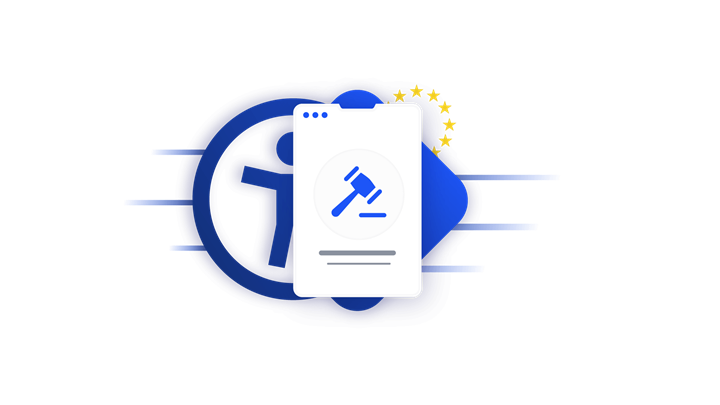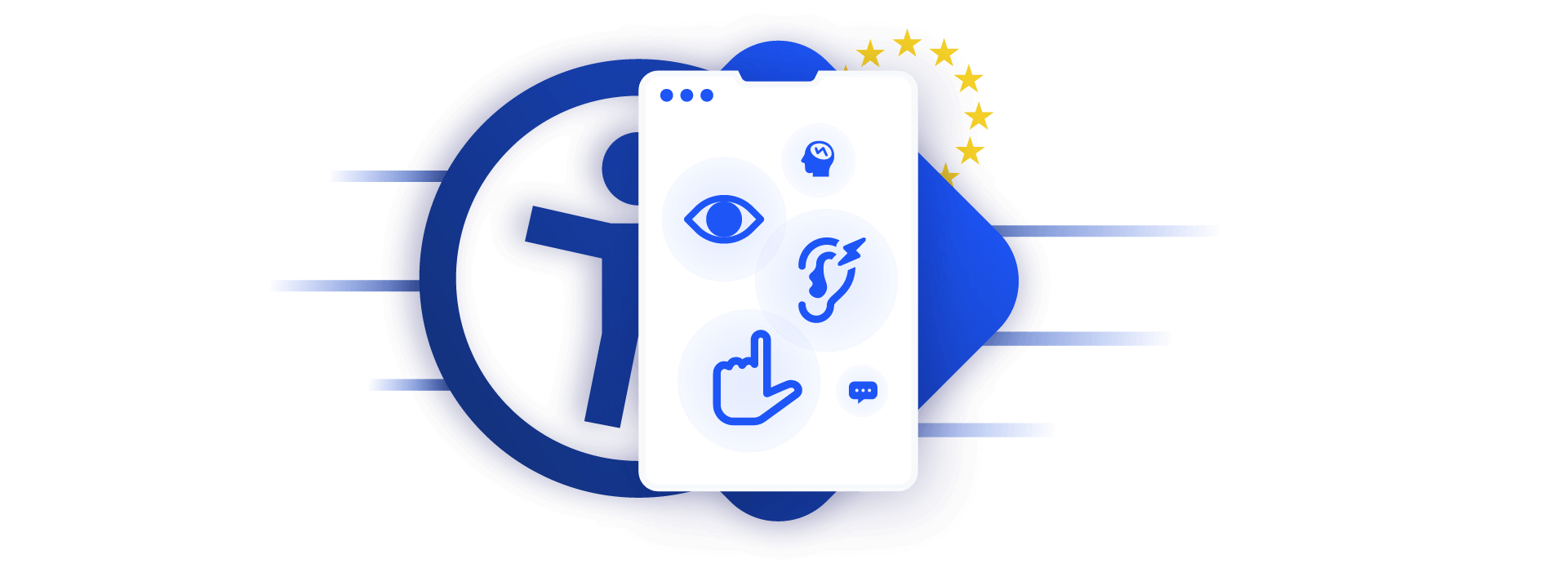Everything you need to know about the EU Web Accessibility Directive and the European Accessibility Act
It is a busy time for online accessibility experts in the European Union. As of September 23, 2020, organizations in the EU public sector are required to have fully compliant websites under the EU Web Accessibility Directive. And by June 23, 2021, their mobile applications will need to be accessible as well.
The next major development in web accessibility regulations is the European Accessibility Act, which will be the first standardized directive applied specifically to the private sector in Europe. Whether you are a private business or a public organization, it is due time to familiarize yourself with these two important directives, as they will have ripple effects around the world.
These two directives focus on different sectors and cover different types of digital media. Let’s go over the differences between the EU Web Accessibility Directive and the European Accessibility Act.
What are the EU Web Accessibility Directive and the European Accessibility Act?
The EU Web Accessibility Directive was born out of an ongoing effort to comprehensively address accessibility issues across the European Union. Starting in the early 2000s and carrying into initiatives such as 2010’s European Disability Strategy and the Mandate 376 Accessible ICT Procurement Toolkit, the EU’s governing bodies have been among the global leaders in creative, functional approaches to providing equal online access for users of all abilities.
The passage of the Web Accessibility Directive in 2016 marked the EU’s most comprehensive accessibility effort to date. The 15-page directive requires all public sector websites and applications in EU member states to implement, enforce, and maintain a uniform set of accessibility standards. Sites and apps that fail to comply with the directive risk fines and other legal penalties, along with the negative publicity and consumer backlash that comes with operating an exclusionary site.
The European Accessibility Act follows in line with these developments by taking the next big step in accessibility, but this time within the private sector. The EU officially adopted the directive in 2019 with the aim to standardize the accessibility requirements for essential products and services. These efforts seek to improve the trade of these products, but also ensure accessible products and services are affordable to those who need them. A key factor that sets the European Accessibility Act apart from the EU Web Accessibility Directive is that it extends the focus beyond web and mobile applications to a broader range of digital products, including, but not limited to, terminals, ATMs, and services and products within the transportation sector, such as ticketing machines.
Who must comply with the EU Web Accessibility Directive and the European Accessibility Act?
Officially, the Web Accessibility Directive applies to public sector bodies. That includes governmental websites such as:
- State, regional, and local authorities
- Bodies governed by public law and financed via public contract, as defined in point (4) of Article 2(1) of Directive 2014/24/EU
- Associations formed by those above, if those associations are established for the specific purpose of meeting needs of general interest, and do not have an industrial or commercial character
There are some exclusions, including public service broadcasters, most schools, and non-governmental organizations (NGOs) that do not provide services “essential to the public” or address the needs for persons with disabilities. For the most part, though, if a website is operated by a public or governmental entity, the EU Web Accessibility Directive is in effect. Each EU member state has the right to broaden the scope of the directive to include other sectors and industries.
The European Accessibility Act applies to manufacturers and providers who sell products and services across European borders that have been deemed essential by the directive. The types of products and services within the scope of the European Accessibility Act are e-commerce services, computers and operating systems, smartphones and devices used for electronic communication, banking services, service terminals, and eBooks. Until the directive is implemented into EU member states’ respective national laws, it is yet unclear what compliance will look like in detail and who exactly it will impact. What is known now is that there are exclusions for micro enterprises, meaning smaller businesses with 10 or fewer employees and with an annual turnover of less than two million euros who can claim undue burden.

When do the European Accessibility Act and the EU Web Accessibility Directive take effect?
The EU Web Accessibility Directive is currently in the final stages of the compliance phase. As of September 23, 2020, all websites in the EU public sector must comply with the directive. And effective June 23, 2021, mobile applications will also have to comply.
The European Accessibility Act, on the other hand, is in the beginning stages of development, as it was only officially adopted by the EU in 2019. Member states have a generous timeframe in which to implement all the required accessibility changes.
- Transposition Phase: Effective June 28, 2022, member states must have a reasonable plan in place for incorporating the European Accessibility Act into their national legislation
- Implementation: Effective July 28, 2025, member states’ national laws must be applied
A more detailed timeline for compliance is expected to follow the June 28, 2022 deadline.
How do the directives impact private organizations?
Although the Web Accessibility Directive only specifically applies to public sector websites and apps, it will have a noticeable impact on many private companies as well. Organizations that regularly do business with or provide products or services such as software providers to governmental sites will need to be sure that their accessibility standards measure up. Private sector companies that offer similar services to those provided by public sites may also risk alienating users with disabilities if their websites or apps provide a less accessible experience.
The European Accessibility Act will affect private organizations that manufacture or supply products and services that fall under the wide range of electronic products considered essential. Businesses will benefit by having clear rules on web accessibility, therefore, reducing potential legal and financial risks. By creating standard regulations, the European Accessibility Act will also mean easier cross-border trading between EU member states. And by making their products and services accessible to a larger portion of the population, private organizations will increase their potential market growth.
How is the EU Web Accessibility Directive different from WCAG?
While there is a good deal of overlap between the EU Web Accessibility Directive and the Web Content Accessibility Guidelines 2.1 (WCAG 2.1), it is worth exploring what sets the two initiatives apart, as well as the implications for both public and private organizations.
The core of the Web Accessibility Directive is, essentially, WCAG 2.0. The directive itself does not include any specific rules for websites and apps to follow to stay in compliance. To find the actual regulations, readers are referred to Standard EN 301 549 of the Accessible ICT Procurement Toolkit, which itself refers to WCAG 2.1 standards for further clarification.
So, if the underlying rules are identical, why are both measures necessary? It boils down to enforcement. WCAG 2.0 and WCAG 2.1 are sets of guidelines laid out by the World Wide Web Consortium—highly influential but not legally enforceable on their own. By enshrining the principles of WCAG in the Web Accessibility Directive, the European Union is officially requiring its member states to abide by WCAG 2.1 Level AA standards. This goes a long way toward establishing uniform rules for online accessibility in the EU.
How to be compliant
To fulfill the WCAG compliance requirements of the EU Web Accessibility Directive, public organizations must ensure their websites and mobile apps fulfill the success criteria for Level A and Level AA per the WCAG 2.1 standard. In addition, organizations must also ensure they have a publicly posted, regularly updated accessibility statement explaining accessible content standards and they must provide users with a link to provide feedback.
The European Accessibility Act does not reference a specific standard. It does, however, outline a set of general accessibility requirements with the main objective being “design for all,” meaning that products and services should be designed to support as many different types of abilities as possible.
Although the European Accessibility Act does not name the WCAG standard, both the WCAG and the directive’s accessibility requirements for websites and mobile apps are grounded in the same four accessibility principles, which state that accessible products should be perceivable, operable, understandable, and robust. So even though the national legislations are under development, familiarizing yourself with the WCAG standard is an excellent starting point to begin planning for accessibility compliance. And accessibility regulations can be expected to continue to increase considering the newly relaunched EU Strategy for the Rights of Persons with Disabilities in March 2021, so now is the perfect time to start.
The first step towards compliance is evaluating the current accessibility of your website. The Siteimprove Website Accessibility Checker is a free tool that scans your website for the most common accessibility issues. Keeping up with compliance is an ongoing process, which is why Siteimprove offers a full web accessibility solution, including both automated software and manual accessibility testing services. To hear more, reach out for a demo of our accessibility tool or learn more about Siteimprove’s manual accessibility testing services.
